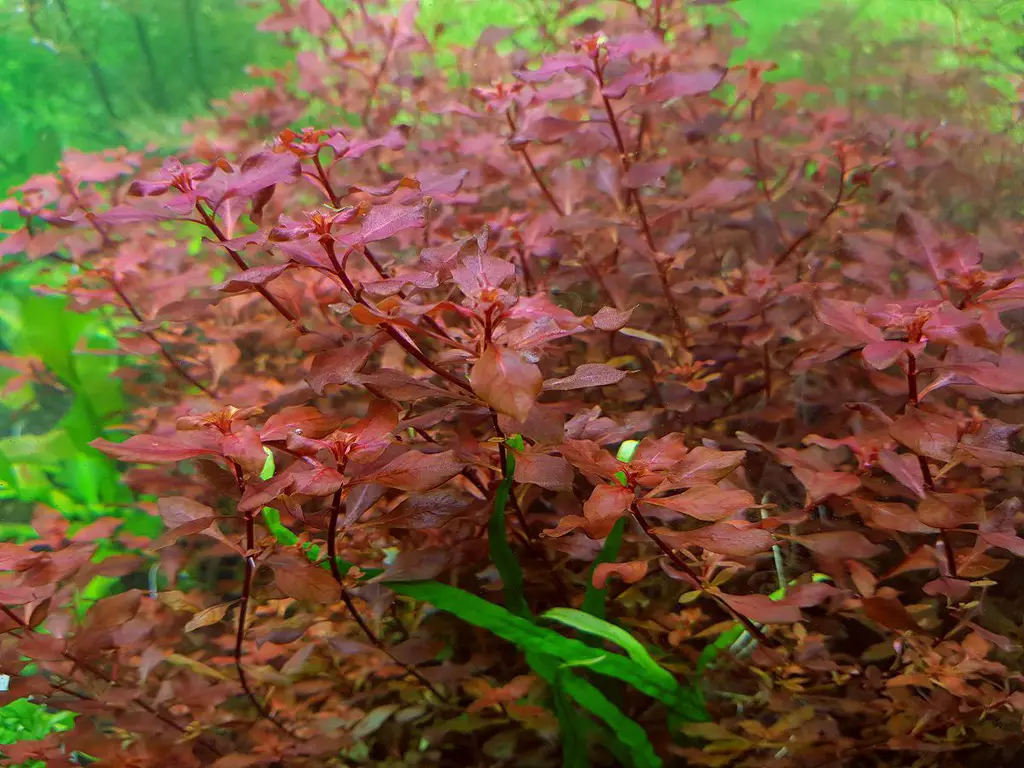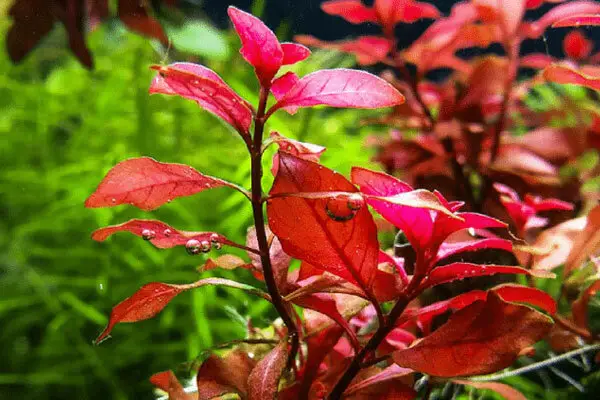The Ludwigia Aquarium Plant belongs to the Cypress family. It is often used to decorate tanks, ponds, and aquariums with plants. When planting, it is important to follow the rules of care, as well as take into account compatibility with other plants and animals.

Table of Contents
Ludwigia Aquarium Plant Habitat
Under natural conditions, the plant is found in warm water bodies of the tropical and subtropical zones. You can find ludwigia in North Africa and South America, in Central Asia and southern Europe.
It can float freely in water or take root in the ground. Differs in an attractive appearance. Stems are tough, branched. Their length can be from 30 to 50 cm. The shape and size of the leaves can be different. In addition, the color varies from species to species.
The roots are poorly developed. Above the surface of the water, flowers of a yellow or light green hue with 4 petals can grow.
Ludwigia Aquarium Plant Types and Varieties
In total, there are about 75 species of ludwigia. In addition, several breeding varieties have been developed. You can keep the plant inside the reservoir or above its surface.
The appearance of a particular species is influenced not only by genetic differences but also by breeding conditions. Many breeding varieties are difficult to distinguish from each other, especially for laymen.

ARCUATE LUDWIGIA ARCUATA
Ludwigia Arkuata (arcuate) is distinguished by flexible long shoots. Leaves are narrow, oblong. On the stems, they are located in pairs. The leaf plates are bright green. May turn reddish brown with good care. Shoots can grow up to 30 cm in length.
The algae grows throughout the year and branches strongly. Better to breed in aquariums or artificial reservoirs with low water levels. To make the plant feel comfortable, you need to regularly trim its tops. Periodically replace some of the water in the aquarium.
Ludwigia Arquat is easily confused with the Brevipes variety. The latter has leaves curved in an arc. The color can be from bright green to yellowish and reddish-brown.
CREEPING LUDWIGIA REPENS
Another name is Ludwigia Natans (Natans). This species is one of the most common in aquariums. It is unpretentious and does not cause difficulties in care.
Ludwigia Aquarium Plant Distinctive features:
- Leaves are oval.
- The upper part of the leaf is bright green, the lower – with a reddish-purple tint.
The subspecies is Ludwigia Rubin – its leaves are distinguished by a bright scarlet color. This variety looks especially impressive against the background of green aquarium plants. Both varieties grow quickly with good care.
The breeders crossed the Repens and the marsh species to create a hybrid variety. It branches quickly and well. You can enhance this property with regular haircuts. The leaves have a glossy surface, bright green or olive color, underneath – reddish.
TORNADO
According to some biologists, the Ludwigia Tornado is a mutation of the Cuba species. The plant was bred in a special nursery in Vietnam. A rare variety is characterized by capriciousness and exacting care.
Compared to the Cuban subspecies, it is smaller. The stems are thick and brittle and must be handled carefully. Leaves form whorls. The shape of the plates is spiral. It is better to plant in small groups along the side and back walls of reservoirs. There, the plant forms lush, beautiful thickets.
Under suitable conditions, the plant can stretch up to 25 cm in a week. When the shoots reach the surface of the water, they begin to branch vigorously. Many side branches are formed.
In order for Ludwigia Tornado to maintain an attractive appearance, it needs to be trimmed regularly. The herb tolerates this procedure easily. The water in the aquarium should be soft and slightly acidic. It is imperative to enrich the environment with carbon dioxide and feed the grass with fertilizers.
GREEN LUDWIGIA
Another name for this species is marsh.
In the wild, it grows in ponds and swamps in tropical areas:
- Western Asia;
- North Africa;
- South America;
- Europe.
In artificial conditions, it is better to breed the plant in an aquarium with a low water level.
External features of green ludwigia:
- long, highly branching stems;
- leaves with petioles, opposite;
- plates are ovoid, bright green, up to 2.5 cm long;
- flowers with several sepals, without a corolla, grow in the leaf axils;
- height – up to 50 cm.
Better to plant in the back and sides of the aquarium. This makes the plant a beautiful backdrop for other plants.
RED SUPER RED
The Super Red variety can be found at sellers under different names:
- sp. “Red”;
- Mini Red;
- Mini Super Red.
In all cases, we are talking about the same species. It was bred in nurseries in Southeast Asia. According to some reports, this is a subspecies of the plant Ludwigia palustris (Palustris), which is smaller in size than its main form.
The leaves of this plant are colored deep red. Brightness is not affected by the intensity of the light. The leaves are arranged on the branches in pairs crosswise.
Growth and development are improved if the environment is saturated with iron and other elements. It is important that the water is always clean. To do this, it needs to be replaced weekly by 20-25%. When well cared for, this cultivar produces lateral stems and forms a lush bush. You can separate the grown branches for reproduction.
Ludwigia Aquarium Plant other types
Other types of Ludwigia that are in demand among aquarists are:
- Inclinata Cuba is an aquatic grass native to the Cuban islands. In nature, it grows in marshy areas. In the aquarium, its leaves become long and narrow, growing close to each other. The color changes from green to copper. The stems are getting shorter.
- Peruvian Diamond has an attractive appearance. It has long, tough stems. The upper part of the leaves can be from green to reddish brown, the lower part is usually bright red. This type is suitable for large aquariums and artificial reservoirs.
- Mato Grosso. This plant lays down on the surface of the water, decorating the aquarium. It has a thin and soft stem, the leaves are colored smoky green.
- Guinean – it has a bright crimson color and tough long stems. It is demanding in care, needs bright lighting and a high content of carbon dioxide in the water.
- Mexico City, or Senegalese, is a relatively new species for aquariums. The stem is creeping, the leaves are long, red-brown. On the surface, there is a pattern that resembles a leopard skin.
- Glandular, or Glandulose, is a plant with thick, powerful stems. Rare in artificial reservoirs, because it requires special care. In underwater specimens, the leaves are reddish, in above-water specimens they are bright pink. Experts recommend growing this species in humid greenhouses.
- Ludwigia Ovalis is a plant with greenish-yellow or reddish leaves, their shape corresponds to the name. The plant is undersized, shoots grow vertically or at an angle, forming lush small bushes.
Ludwigia Aquarium Plant Growing Conditions and care
In order for the plant to develop well, it needs to create suitable conditions:
- The nutrient soil for ludwigia should be medium silted. You can add small balls of clay to it – this is a good feeding. It is recommended to sprinkle with fine gravel in a layer up to 4 cm.
- The water should be of medium hardness and have a neutral or slightly acidic reaction. It is regularly changed, otherwise plaque will form on the leaves.
- The optimum temperature of the environment is + 20 … + 25 ° С, the changes are permissible within the range of + 16 … + 19 ° С. If the temperature is too low, the plant sheds its leaves, stops developing and dies.
- In winter and in cloudy weather, the plant requires additional lighting, but not too bright. Daylight hours should be 12 hours.
- It is not necessary to add fertilizers. However, experienced aquarium owners recommend adding special feeding – with them the culture grows faster. In addition, such additives prevent the development of diseases in the plant.
Ludwigia Aquarium Plant propagation and transplant
Reproduction of aquatic grass takes place using cuttings. The best time to do this is in the fall. If the conditions are right for the plant, it will multiply in the same aquarium on its own.
Algorithm for transferring to another body of water:
- The tops of the stems are carefully cut with sharp scissors. You should get cuttings of 10 cm.
- Cut shoots are immediately planted in the ground. We need a special nutrient substrate. You can use a clay backing.
- The seedlings take root quickly and begin to grow actively.
To make the bush more lush and thick, several leaves are plucked from it. Side shoots soon begin to grow in these places. The result is a lush crown.
You can transplant an adult Ludwigia to a new location to change the decor of the aquarium. Dig out the bush completely and pinch off the tip of the root. They are planted in the ground in a new place. This procedure does not harm the plant.
Ludwigia Aquarium Plant compatible fishes and Plants
Like other aquarium plants, ludwigia does not blend with all aquarium inhabitants. This applies to both flora and fauna.
It is not recommended to plant a plant:
- In a body of water where fish who like to dig the ground live. Ludwigia has a weak root system and may suffer.
- Near large plants that block light.
- Together with plants that do not like bright light.
It is useful to plant Ludwigia in an aquarium if the fry suffers from vitamin deficiencies. In addition, schools of fish will be able to take refuge in the thickets of the plant. Most ludwigia species should not be planted in waters where shrimp live.
USE IN AQUA DESIGN
Grass can be used in a variety of ways to create an eye-catching aqua design:
- It is best to plant ludwigia in a pond with a bright green background. The plant forms contrasting bright scarlet or copper spots.
- Can be planted at the back wall at the same time shoots with red and green foliage.
- If you plant a bush in the center of the reservoir, you will need to cut it regularly.
- To make the thickets thick, lateral shoots are cut off from them.
- To make the plant stretch up, remove the lower leaves and branches.
You can put ludwigia in the foreground. However, at the same time, it must be constantly trimmed and thinned. You should not plant grass in shaded areas there it will stop growing and eventually die.